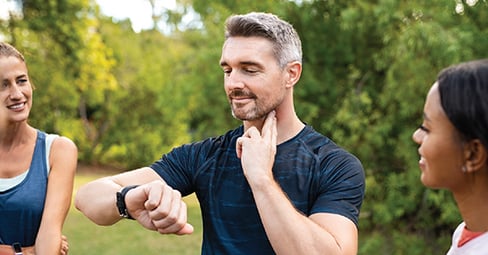This is the first of a blog series providing an introduction to three wellness models Larry Chapman teaches as part of his wellness certification programs and how to knowledgeably promote each to c-suite.
Since CoreHealth is fortunate to partner with thought leaders around the globe, we wanted to take this  topic a step further and sought expertise from wellness thought leader Larry Chapman of the Chapman Institute. The Chapman Institute’s mission is to offer training products for professionals in the Worksite Wellness field that allow them to deliver world-class wellness programs and reach their own career goals.
topic a step further and sought expertise from wellness thought leader Larry Chapman of the Chapman Institute. The Chapman Institute’s mission is to offer training products for professionals in the Worksite Wellness field that allow them to deliver world-class wellness programs and reach their own career goals.
To deliver world-class wellness programs, it’s important to identify where you are at as an organization and be realistic about your objectives and how you will achieve them within your wellness model. Helping employees to improve their health and well-being contributes to better engagement and employee performance – ultimately impacting the bottom line (which the c-suite likes!)
Start Small - Don't Boil the Ocean
As an example, if you don’t currently have a healthy culture which may include a heavy smoking population, jumping in to a results-driven wellness model (more details to come) won’t set you up for success and could potentially be frustrating to employees. As with most things in life, it’s best to start small and evolve vs. trying to boil the ocean from the start.
Remember: 20% of people are intrinsically motivated by wellness (1 out of 5). You have to focus on engaging those not intrinsically motivated.
The 3 Wellness Models
This 4-part series is an introduction to the three major wellness models Larry teaches as part of his wellness certification programs. These models outline the strategies and how to knowledgeably promote each to the c-suite (e.g. CEO, CFO, CHRO, etc.) so you can position your current (or desired) program appropriately.
As a wellness professional, your success depends on your ability to meet expectations so you need all the skills to level set what your senior executives can expect.
Wellness Model
|
Feel Good
Wellness Model
|
Traditional
Wellness Model
|
Traditional
Results-Driven
Wellness Model
|
Objective
|
- Improve morale and get employees engaged.
|
- Ramp up engagement and interest in health and well-being for the intrinsically motivated.
- See some health improvement
|
- Realize measurable results
- Deliver world class wellness
|
Perfect for
|
Organizations that:
- Have limited wellness budgets
- Have young, healthy employees
- Lots on the go / strained employee relations
|
Organizations that:
- Are done with ‘feel good wellness’ model.
- Modest wellness budget
- Have a trusting culture
- Want a flexible approach
- Want to improve overall employee performance
|
Organizations that:
- Are done with ‘traditional wellness’ model.
- Want proven ROI
- Have major wellness budget
- Have a trusting culture
- Want to include spouses
- Want documented results
|
Approach
|
- Encouraging employees to move more and evaluate health behaviors.
- A few fun wellness challenges and activities mostly focused on education, experience, and enrichment.
- Examples: step challenges, health fairs, screenings, free fruit, educational newsletters, etc.
|
- Tactical (not strategic)
- Provide lots of wellness choices and options
- Use-at-will (not heavily incentive based)
- Mix-and-Match, menu-based programming
- Examples: wellbeing assessments, screenings, walking clubs, fitness facility, corporate wellness portal, few policies.
|
- Strategic vs. tactical
- Metric-driven
- Integration with Employee Assistance Provider, Fitness Centres, Occupational Health & Safety, community resources, etc.
- More incentive-driven
- Stronger on ROI & VOI
- Examples: assessments, phone apps, integrated policies, wellness coaching, larger incentives, wellness ambassadors, mentors, cultural norms.
- Higher AMSO (Michael O’Donell, Journal of Health Promotion).
- Awareness - Ongoing Method for Raising Awareness
- Motivation – enhancing intrinsic motivation - usually through extrinsic incentives
- Skill Development - help people learn new skills e.g. lunch and learns, coaching, etc.
- Opportunity - to practice new skills.
|
Expected Results
|
- Minimal economic returns (it won’t pay for itself)
|
|
- Measureable economic returns
|
Measurement
|
- Increased employee satisfaction
- Participation
- Success stories
|
- Some improved health behaviors
- Some health risk reduction
- Counting activity
|
- Decreased health costs
- Decreased absenteeism
- Increased employee satisfaction
- Increased productivity
|
Additional Comments
|
- You will discover your early adopters
|
- Your early adopters may evolve to champions and help inspire/motivate co-workers
|
- You achieve a ‘culture of health’.
|
If you haven’t seen this model before, you may be able to easily identify which model your wellness program naturally fits into plus gain some insight into where you they can evolve to.
Supporting Your Wellness Model
As your wellness programs grow and develop, you will need to focus on delivering them more effectively and likely experience an increase in administration. At a certain point in the evolution, many organizations recognize they just can’t manage it through spreadsheets, Sharepoint and email – it may be time to investigate wellness technology. If you are at that point, please reach out to CoreHealth.
About CoreHealth Technologies
CoreHealth Technologies Inc. is the leading corporate wellness platform trusted by more than 1000 organizations, ranging from medium-sized businesses to Fortune 500 enterprises. At CoreHealth, we believe that developing the best employee wellness programs is all about giving wellness companies the right code, design and access to the latest innovations. With the most customization, integrations and reliability of any software in its class, CoreHealth’s powerful wellness technology lets users focus on growing great companies. For more information, explore the CoreHealth website
 topic a step further and sought expertise from wellness thought leader Larry Chapman of the Chapman Institute. The Chapman Institute’s mission is to offer training products for professionals in the Worksite Wellness field that allow them to deliver world-class wellness programs and reach their own career goals.
topic a step further and sought expertise from wellness thought leader Larry Chapman of the Chapman Institute. The Chapman Institute’s mission is to offer training products for professionals in the Worksite Wellness field that allow them to deliver world-class wellness programs and reach their own career goals. 


